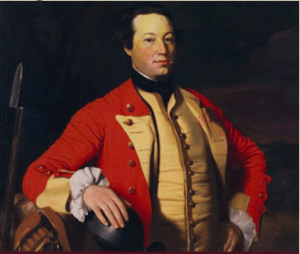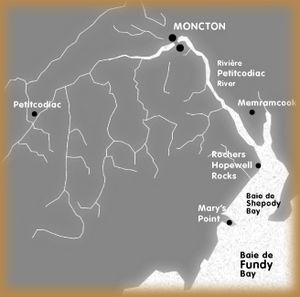Petitcodiac River campaign facts for kids
Quick facts for kids Petitcodiac River campaign |
|||||||
|---|---|---|---|---|---|---|---|
| Part of the French and Indian War | |||||||
 George Scott by John Singleton Copley (c.1758), The Brook |
|||||||
|
|||||||
| Commanders and leaders | |||||||
|
|
||||||
| Units involved | |||||||
|
|||||||
The Petitcodiac River campaign was a series of military actions by the British from June to November 1758. These events happened during the French and Indian War, which was part of a bigger conflict called the Seven Years' War. The main goal of this campaign was to remove the Acadians who lived along the Petitcodiac River or had sought safety there. Many Acadians had moved to this area to escape earlier deportations, like the one from Ile Saint-Jean.
British forces, led by George Scott, carried out these operations. Groups like William Stark's company of Rogers Rangers, Benoni Danks's men, and Gorham's Rangers were involved. During this time, the suffering of the Acadians became much worse. The British also targeted other areas like Cape Sable, the Gulf of St. Lawrence, and the St. John River.
Why the Campaign Happened

The British took control of Acadia in 1710 after the Conquest of Port Royal. For the next 45 years, the Acadians refused to promise their full loyalty to Britain. During this time, many Acadians helped the French by fighting against the British. They also kept important supply routes open to French forts like Louisbourg and Beausejour.
During the Seven Years' War, the British wanted to stop the Acadians from being a military threat. They also wanted to cut off the supplies the Acadians were sending to Louisbourg. To do this, the British decided to deport, or forcibly remove, the Acadians from their homes.
The first wave of these deportations began in 1755 with the Bay of Fundy campaign. Many Acadians fled these operations. They moved to what is now New Brunswick and the French colony of Ile Saint-Jean (today known as Prince Edward Island).
After the British captured Louisbourg in 1758, many Acadians left Ile St. Jean for New Brunswick. This started the second major wave of the Expulsion from Ile Saint Jean and Cape Breton. It then continued strongly in New Brunswick. Historians believe this second wave was even more devastating for the Acadians than the first.
The Petitcodiac River is located between two smaller rivers: the Shepody River and the Memramcook River. Locals often called these three waterways "Trois-Rivières" (Three Rivers). Weeks after the Expulsion began in 1755, British forces raided villages at Chipoudy and Petitcodiac.
On November 17, 1755, George Scott led 700 troops to attack 20 houses at Memramcook. They arrested the Acadians who remained and killed 200 farm animals. Even after these raids, Acadians returned to these villages. Their numbers grew as deportations continued from Nova Scotia, Prince Edward Island, and Cape Breton.
In 1757, Captain John Knox was ordered to join a large force of 800 men. Their mission was to march against Chipoudy, which was thought to be where Acadian and Mi'kmaq raids on Chignecto were starting. In March 1758, Gorham's Rangers raided Chipoudy again. They found only women and children, as the men had gone to Fort Cumberland to attack a British ship. The Rangers were surprised at how quickly the community had rebuilt after the earlier raid.
The Campaign in Action
In June 1758, Lieutenant Meech of Benoni Danks' Rangers went up the Petitcodiac River with 55 men. They suspected this area was a base for Acadian and Mi'kmaq raids. They met 40 Acadians but could not capture them.
On July 1, 1758, Danks himself began to chase the Acadians. They reached what is now Moncton. Danks' Rangers ambushed about 30 Acadians, who were led by Joseph Broussard (Beausoleil). Many Acadians were forced into the river, three were killed, and others were captured. Broussard was badly wounded. Danks became known as a very tough Ranger in local stories.
In September 1758, Roger's Rangers burned an Acadian settlement of 100 buildings. The Acadians captured five British soldiers and took them to Miramachi. Among the prisoners were William Caesar McCormick of William Stark's rangers and his small group. They were held at Miramachi and then Restigouche before being released later.
On November 12, 1758, Danks' Rangers sailed up the river. The next day, they returned with four men and 12 women and children as prisoners. These prisoners told Danks where Joseph Broussard's home was (near present-day Boundary Creek). Danks' company immediately sailed to attack Broussard's home. By the time Danks arrived, the house was empty. Danks killed the animals and burned the fields and village.
The Rangers then returned to the river. Captain Silvanus Cobb continued to transport Rangers up and down the river. For two nights, November 13–14, they destroyed houses and crops. On November 14, Acadian militia appeared early in the morning. Two of Danks' Rangers were missing. The Rangers overpowered the Acadians when Danks' reinforcements arrived. The Rangers took a dozen women and children as hostages. Joseph Gorham reported that he had burned over a hundred homes. Danks reported destroying 23 buildings.
After these actions, the Rangers returned to Fort Frederick at the mouth of the St. John River with their prisoners.
What Happened Next
The Acadian refugees from the Petitcodiac River campaign moved to the Penobscot River area. British officers Preble and Pownall planned to clear this region in early 1759.
A group of regular soldiers led by Lieutenant-Colonel Andrew Rollo arrested and deported Acadians during the Ile Saint-Jean campaign.
Major General Amherst sent Brigadier James Wolfe to the northeast coast for the Gulf of St. Lawrence campaign (1758). Wolfe had three full regiments and seven warships to destroy Acadian fields and settlements. After Wolfe left the area, the 1760 Battle of Restigouche led to the capture of hundreds of Acadians at Boishébert's refugee camp at Petit-Rochelle.


